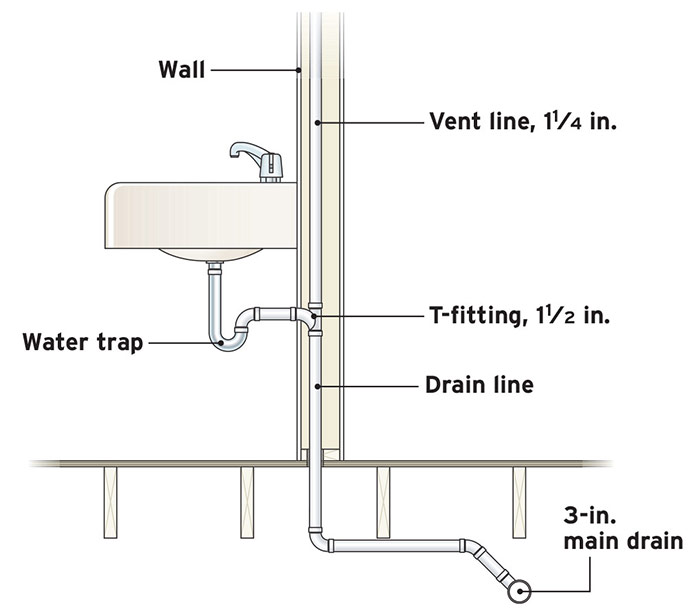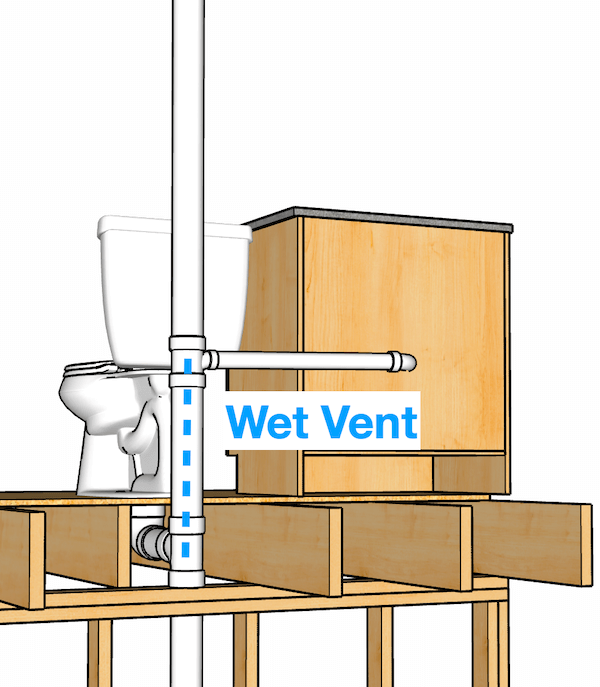The Necessity of Proper Ventilation in Home Plumbing Systems
The Necessity of Proper Ventilation in Home Plumbing Systems
Blog Article
We have uncovered this post about What Is A Plumbing Vent & How Do They Work? directly below on the internet and felt it made good sense to talk about it with you on this site.

Appropriate air flow in pipes systems is commonly neglected, yet it is vital for keeping the capability and safety of your home's pipes. Air flow aids manage atmospheric pressure, protect against the build-up of unsafe gases, and ensure the effective removal of waste. In this overview, we will check out the significance of correct plumbing ventilation, exactly how it works, and the benefits it brings to your plumbing system.
How Ventilation Functions in Pipes Solutions
Air Pressure Policy
Correct ventilation preserves balanced atmospheric pressure within the plumbing system. When water flows via pipes, it displaces air. Without ample air flow, this variation can create unfavorable pressure, resulting in slow down drains pipes or siphoning of water from catches, which can create undesirable smells to seep into the home.
Stopping Sewer Gas Buildup
One of the most important features of plumbing vents is to stop drain gases, such as methane and hydrogen sulfide, from building up within the home. These gases can present severe health and wellness dangers and are highly combustible. Vent pipelines allow these gases to escape securely outdoors.
Assisting in Waste Removal
Ventilation assists in the efficient elimination of wastewater by stopping airlocks in the drainage system. When air can stream openly via the vents, it permits water and waste to move smoothly via the pipelines, reducing the risk of blockages and backups.
Advantages of Proper Ventilation
Improved System Efficiency
Correctly ventilated pipes systems operate extra successfully, with fewer obstructions, faster draining, and less strain on the pipelines. This efficiency extends the life-span of the pipes system.
Improved Air High Quality
By avoiding sewer gases from entering your home, proper ventilation adds to better indoor air high quality, making your living atmosphere healthier and a lot more comfy.
Protecting Against Water Damages
Adequate air flow aids protect against water from being siphoned out of traps, which can result in sewage system gases entering the home and triggering water damages with time.
Steps to Make Sure Appropriate Ventilation
Consulting Plumbing Codes
Constantly speak with neighborhood plumbing codes when designing or customizing your pipes system. These codes give the needed guidelines for correct airing vent and ensure your system fulfills security standards.
Routine Inspection and Maintenance
Normal evaluations can assist identify prospective air flow concerns before they come to be major troubles. Maintenance tasks, such as cleansing vent pipelines and checking for clogs, are crucial for maintaining the system in good working order.
Expert Installment
For brand-new installations or significant adjustments, it's smart to work with an expert plumbing professional. They have the competence to make certain the ventilation system is correctly made and installed according to code.
Recognizing Ventilation in Plumbing
Air flow in pipes describes the network of pipelines that enable air to flow through the drain system. These vents serve multiple functions, consisting of controling atmospheric pressure within the pipelines, stopping sewer gases from entering the home, and helping in the smooth flow of wastewater.
Sorts Of Plumbing Vents
Key Heap Vent
The major stack air vent, additionally referred to as the air vent stack, is the primary vent in a plumbing system. It extends from the main drain align through the roofing system, allowing gases to escape and fresh air to enter the system.
Branch Vent
Branch vents connect to the primary stack vent and offer specific fixtures, such as sinks, toilets, and showers. These vents guarantee that each fixture has appropriate air flow to operate correctly.
Air Admittance Valve (AAV).
An Air Admittance Shutoff (AAV) is a one-way shutoff that enables air to get in the plumbing system without the requirement for a typical air vent pipe extending with the roofing system. AAVs are generally made use of in remodellings or areas where installing a standard air vent is not practical.
Indicators of Poor Air Flow in Pipes.
Slow Draining Fixtures.
If your sinks, bathtubs, or commodes are draining slowly, it could be an indicator of poor ventilation. Inadequate air circulation can produce a vacuum effect, making it tough for water to drain pipes appropriately.
Gurgling Sounds.
Gurgling noises coming from drains are frequently a result of air being sucked via water traps due to unfavorable pressure in the pipelines. This is a clear sign of not enough ventilation.
Undesirable Odors.
Sewer odors inside your home are a warning that your plumbing system is not effectively aerated. This could indicate that sewer gases are not being appropriately vented outside, bring about possibly hazardous conditions.
Usual Air Flow Errors.
Inadequate Vent Sizing.
Making use of undersized vent pipelines can lead to bad air flow and stress discrepancies in the system. It's necessary to utilize vents that meet the specific needs of your plumbing system.
Improper Vent Placement.
Placing vents also much from the components they serve can lower their performance. Correct placement makes sure that air can stream easily and effectively with the system.
Ignoring Code Needs.
Building ordinance provide specific standards for pipes ventilation. Overlooking these codes can cause a system that fails to operate appropriately and may result in pricey repair services or carcinogen.
Verdict.
Proper air flow is a crucial element of any pipes system, ensuring that it works effectively and safely. By understanding the importance of air flow, acknowledging the indicators of inadequate air flow, and taking actions to keep your system, you can avoid expensive concerns and protect your home's air quality.
4 Things You Should Know About Your Plumbing Vents
What Plumbing Vents Are
Also called a vent stack, a plumbing vent is a vertical pipe attached to your drain line that runs through your roof. The plumbing vent pipe, or plumbing air vent, removes gas and odors from your plumbing system and allows fresh air to enter the pipes, helping the water to flow out of the drain pipes.
What Plumbing Vents Do
Plumbing vents have two basic functions. One of which is to allow unpleasant smelling wastewater and sewer gasses to escape your plumbing system instead of entering your home. Plumbing vent pipes are typically located on roofs, away from windows, to ensure the fumes exit the home completely.
The other function of the plumbing vent is to move fresh air into your plumbing system. This helps move water through every plumbing fixture in your house, like toilets and sink drains. Think of the way in which you need to let a little air into the bottle as you pour soda in order to make the drink flow smoothly.
Different Types of Plumbing Vents
True vent: This is the most common vent option. In simplest terms, a true vent is a vertical pipe attached to your drain line that exits through the roof. They often function as the main vent that other fixtures can connect to. Re-vent pipe or auxiliary vent: Attached to the drain line near specific plumbing fixtures, re-vent pipes run up and over to connect to the main vent. Common vent: Two plumbing fixtures installed on opposite sides of a wall are typically tied into the vent stack using something known as a sanitary cross. Wet vent: This venting option operates as a drain pipe and a vent at the same time. Wet vent drainage systems drain water from one fixture while venting the air from another. Although they’ve been used for over 100 years, wet vent systems have only recently been added to the plumbing code in many areas. If you’re planning on installing one in a bathroom remodel, make sure you check your local code prior to construction. Loop vent: For free-standing fixtures like kitchen island sinks, loop vents are ideal. These vent pipes run under the floor, rise from the P-trap, and create a loop inside the cabinet sink. Air admittance valve: An AAV is a one-way mechanical valve typically installed at the site of the plumbing fixture. AAVs allow venting to occur without having to tie into a larger venting system. They’re ideal for venting fixtures where you aren’t able to easily connect to an existing vent system. Common Plumbing Vent Issues
Although vent pipes typically don’t have water flowing through them, they’re still subject to many typical plumbing issues. For example, clogs are one of the most common problems associated with sewer vent pipes. If your vent pipe gets clogged, all of your plumbing fixtures tied into the vent stack will be affected.
A sink with a slow drain that bubbles and gurgles or a strong sewage smell around your toilet are both indicators that your toilet vent pipe is clogged. Because most vent pipes exit through the roof, old leaves, twigs or even a bird’s nest could be clogging the pipe.
Clogs in your vent pipe system cause a buildup of negative pressure, meaning that water won’t be able to flow out of your home very well. It’s similar to putting your finger over the opening of a straw to trap water inside. When you remove your finger, the water is able to flow out of the straw.
If you suspect you have any blockage in your vent, make sure you have a professional come examine the situation. Left unchecked, a blocked air vent can lead to other costly repairs, like leaks and sediment buildup.
Under Pressure
Pipe vents are essential aspects of a home’s plumbing system. Owning a home means learning about all sorts of things you never put much thought into before. But by understanding as much as you can about the important systems of your home, you can keep those budgets intact and those anxiety levels low.
https://www.homeserve.com/en-us/blog/home-improvement/plumbing-vents/

As a fervent reader on The Upsides of Proper Ventilation in Plumbing Design, I thought sharing that excerpt was smart. Do you know somebody else who is in to What Is a Plumbing Vent and Why Is It Important? Be sure share it. I thank you for reading our article about What Is a Plumbing Vent and Why Is It Important.
Call Today Report this page